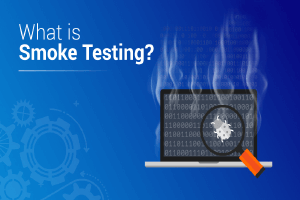Introduction to smoke testing
Smoke testing is a form of software testing in which the major functionality of an application is tested to confirm that it works properly. It is also called ‘Build Verification Testing’. It contains a set of non-exhaustive tests that verify the build is stable enough for further testing.
Smoke tests are created in order to verify that the basic functionality of a software package runs properly or not. If the tests fail, the testing team rejects the build until those basic errors don’ fixed.
The term ‘smoke testing’ is derived from the hardware testing, where a device when first switched on is tested for any smoke or fire. This ensures that the hardware’s basic components are working properly and no major failures are found.
Similarly, when we do smoke testing on the application, this means that we make sure that there are not any major failures before giving the build for exhaustive testing.
When to use it
It is used in the following scenarios:
- Smoke testing is done by developers before giving the build to the testing team.
- Later on, smoke testing is done by the testers before they begin the detailed testing.
- Smoke testing is done to make sure that the basic functionalities of the application are working fine.
Advantages of Smoke Testing
- It helps to identify issues in the early phase of testing.
- It improves the quality of a system.
- It reduces risks.
- Progress is easier to access.
- Detecting critical errors and correction of errors is effortless.
- It runs very quickly.
- It minimizes integration risks.
- Finds issues and introduced in the integration of modules.
- Reduced Manual Intervention.
- More Coverage in less time.
- It validates the functionality of the product.
Disadvantages of Smoke testing:
- Unlike other forms of software QA testing, it does not cover all functionalities of the application.
- Testers perform smoke testing with a small set of test cases. Hence, they cannot use test cases to identify the critical bugs and performance issues in the software.
- It’s non-exhaustive testing with a small number of test cases because of which we are not able to find the other critical issues.
The following tools will help you to make your smoke testing efforts more efficient:
- Check panel: Checkpanel is a great testing management tool that helps to keep your test cases organized. It saves the results of each test run. You can set reminders for the future so that you won’t forget your smoke tests ever again.
- Selenium IDE: The Selenium-IDE (Integrated Development Environment) is a tool used to develop Selenium test cases. It is an easy-to-use Chrome and Firefox extension and is generally the most efficient way to develop test cases. It saves the user’s actions in the browser, using existing Selenium commands with parameters defined by the context of that element. This is not only a time-saver but also the best way of learning Selenium script syntax.
- Xenu’s Link Sleuth: Xenu’s Link Sleuth a simple tool that will automatically find all broken links on your site. This simple tool grabs a root webpage and scans it completely in order to test every single link and check all of them work properly or not.
People having good command over the French language can get a French certification from StudySection. StudySection offers both beginner level and expert level French certification exams to test the ability to communicate in the French language.




